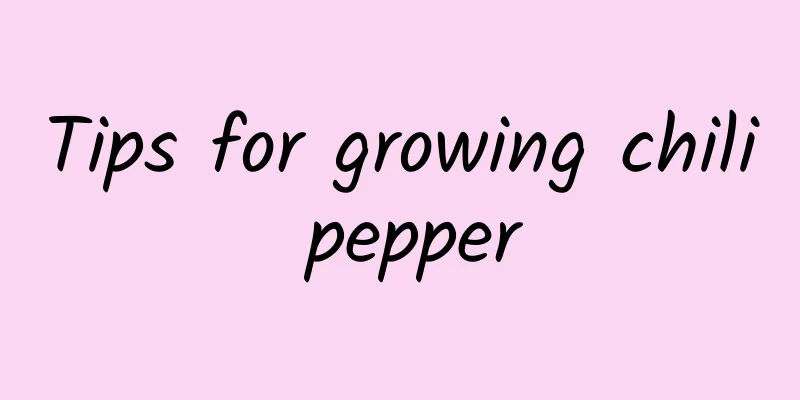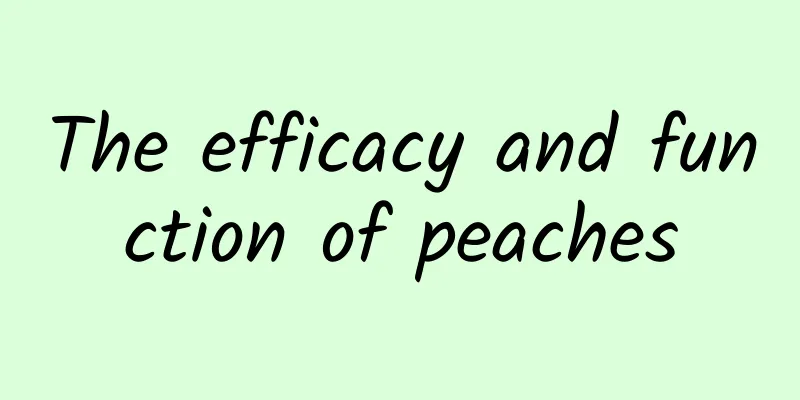Tips for growing chili pepper

|
Today I will introduce to you how to propagate chili peppers. Before sowingSowing: Sowing is often carried out in summer: Substrate disinfection: The best way to disinfect the substrate used for sowing is to put it in a pan and fry it, which can kill all diseases and insects. Germination: Soak the seeds in warm water (about the same temperature as washing water) for 3 to 10 hours until the seeds absorb water and swell. For common seeds that are easy to germinate, this work can be omitted. Sowing method: For tiny seeds that are difficult to pick up with hands or other tools, you can wet one end of a toothpick with water and stick the seeds one by one on the surface of the substrate, covering the substrate 1 cm thick, and then put the sowing pot into water with a depth of 1/2 to 2/3 of the height of the pot, and let the water soak up slowly (this method is called "pot immersion method"); For seeds that are larger and can be picked up by hand or other tools, place the seeds directly into the substrate and sow them at a spacing of 3×3 cm. Cover the substrate after sowing with a thickness of 2 to 3 times the size of the seeds. After sowing, use a sprayer or fine-hole sprinkler to wet the sowing substrate. When the soil in the pot is slightly dry, water it again. Still, be careful not to water too hard to avoid washing the seeds away. After sowingAfter sowing and the seedlings emerge from the soil, the film should be removed in time, and the seedlings should be exposed to sunlight before 9:30 in the morning or after 3:30 in the afternoon, otherwise the seedlings will grow very weakly; after most of the seeds have emerged, they need to be thinned out appropriately: pull out the diseased and unhealthy seedlings, and leave a certain space between the remaining seedlings; when most of the seedlings have grown 3 or more leaves, they can be transplanted into pots. Cutting propagationThe cutting medium is the nutrient soil or river sand, peat soil and other materials used for cutting. Due to the limited conditions of home cutting, it is difficult to get the ideal cutting medium. It is recommended to use the cutting medium that has been prepared and sterilized; medium-coarse river sand is also OK, but it must be rinsed with clean water several times before use. Sea sand and river sand in saline-alkali areas should not be used, as they are not suitable for the growth of flowers and plants. Selection of cuttings: The branches used for cuttings are called cuttings. Usually combined with the work of pinching, the thick, disease-free top branches are used as cuttings, and the top branches are directly used for cuttings. Management temperature after cutting: The optimum temperature for cutting rooting is 18℃~25℃. If it is lower than 18℃, the cutting rooting is difficult and slow; if it is higher than 25℃, the cutting cut is easily infected by pathogens and rots, and the higher the temperature, the greater the rot rate. When the temperature is low after cutting, the insulation measure is mainly to wrap the flower pot or container used for cutting with a film; when the temperature is too high after cutting, the cooling measure is mainly to shade the cutting, blocking 50-80% of the sunlight, and at the same time, spray the cutting 3-5 times a day. On sunny days with higher temperatures, spray more frequently, and on rainy days with lower temperatures and higher temperatures, spray less frequently or not at all. Humidity: After cutting, the relative humidity of the air must be maintained at 75-85%. Humidity can be increased by spraying the cuttings 1-3 times a day. The higher the temperature on sunny days, the more times you spray. The lower the temperature on rainy days, the less or no spraying is needed. However, excessive spraying can easily cause the cuttings to be infected by pathogens and rot, because many types of pathogens exist in water. Light: Cutting propagation cannot be separated from sunlight. However, the stronger the light, the higher the temperature inside the cuttings, the more vigorous the transpiration of the cuttings, the more water consumed, and it is not conducive to the survival of the cuttings. Therefore, after cuttings, 50-80% of the sunlight must be blocked, and after the roots grow out, the shading net can be gradually removed: on sunny days, the shading net should be removed at 4:00 p.m. every day, and covered before 9:00 a.m. the next day. Potting or transplanting: When potting the seedlings, first put a 2-2 cm thick coarse-grained substrate or expanded clay at the bottom of the pot as a water filter layer, and sprinkle a layer of fully decomposed organic fertilizer as base fertilizer, about 1-2 cm thick, and then cover with a layer of substrate, about 1-2 cm thick, and then put the plants in to separate the fertilizer from the roots to avoid root burn. The substrate for potting can be one of the following. Garden soil: slag = 3:1; or garden soil: medium coarse river sand: sawdust (vegetable residue) = 4:1:2; or one of paddy soil, pond mud, and leaf humus. Or peat + perlite + ceramsite = 2 parts + 2 parts + 1 part; garden soil + slag = 3 parts + 1 part; peat + slag + ceramsite = 2 parts + 2 parts + 1 part; sawdust + vermiculite + medium coarse river sand = 2 parts + 2 parts + 1 part. After potting, water thoroughly once and place in a slightly shaded environment for maintenance for a week. When transplanting seedlings, dig a planting hole first, sprinkle a layer of organic fertilizer as base fertilizer (basal fertilizer) at the bottom of the planting hole, about 4 to 6 cm thick, then cover it with a layer of soil and put the seedlings in to separate the fertilizer from the roots to avoid burning the roots. After putting the seedlings in, backfill the soil to cover the roots, tamp the soil with your feet, and water it thoroughly. Pinching: Generally, pinching is done twice before flowering to encourage the germination of more flowering branches: One to two weeks after potting, or when the seedlings are 6 to 10 cm tall and have more than six leaves, remove the top and keep the lower 3 to 4 leaves to promote branching. 3 to 5 weeks after the first pinching, or when the side branches grow to 6 to 8 cm long, do the second pinching, that is, remove the top of the side branches and keep the 4 leaves below the side branches. After two pinchings, the plant shape will be more ideal and the number of flowers will be more. |
<<: Nutritional value and therapeutic effects of zucchini
Recommend
How to grow succulent plants? Precautions for growing succulent plants
Small and cute succulents are the favorites of ma...
How is DFJ Investments? DFJ Investments Review and Website Information
What is Draper Fisher Jurvetson? Draper Fisher Jur...
The efficacy and function of passion fruit
Passion fruit is a sweet and juicy tropical fruit...
The efficacy and function of citrus leaves The medicinal value of citrus leaves
Citrus leaves are the leaves of the citrus plant....
How is Lebu_Rockport? Lebu_Rockport review and website information
Rockport is a famous American shoe brand. It was f...
The efficacy and function of Cornus officinalis and how to eat Cornus officinalis
Cornus officinalis is a traditional Chinese medic...
Nutritional value of oatmeal
How much do you know about the recipe of oatmeal ...
Can you eat sprouted potatoes?
Potatoes are vegetables that people often eat, an...
How is Montblanc? Montblanc reviews and website information
What is Mont Blanc? Mont Blanc is a world-class ma...
Can dried dragon beard algae be eaten? How to eat dragon beard algae
Many people have eaten fresh dragon's beard a...
What is the Prime Minister of Cambodia like? Reviews and website information of the Prime Minister of Cambodia
What is the website of Cambodian Prime Minister? T...
How to plant pond water grass seeds How to plant pond water grass
Planting some green aquatic plants in the pond wi...
Ingredients and steps for making Rose Lover Porridge
Rose is a kind of health tea that can make your f...
The effects, functions and contraindications of kudzu flower
Kudzu flower is the flower of the leguminous plan...
The efficacy and function of lily pumpkin porridge
Many people like to eat porridge, among which lil...









